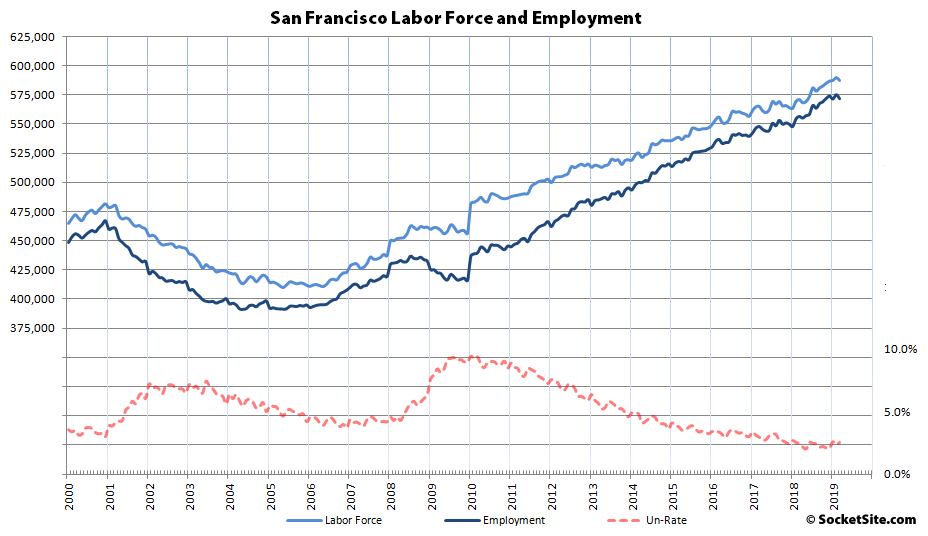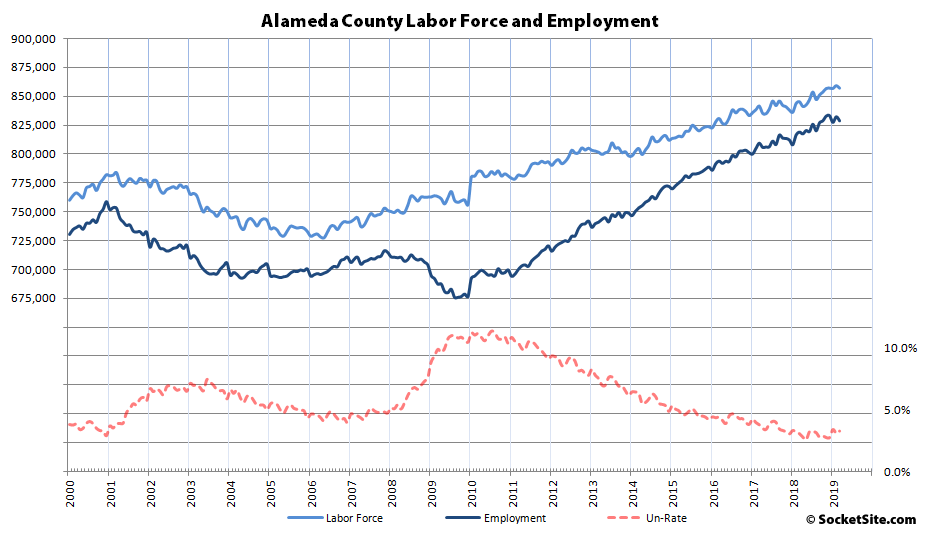Having hit a record high in February, the number of people living in San Francisco with a paycheck, which typically ticks up in March, actually decreased by 3,400 last month to 572,000 and the unemployment rate, which hit a record low of 2.1 percent at the end of last year, inched up to 2.6 percent.
That being said, there are still 135,300 more people living in San Francisco with paychecks than there were at the start of 2010 and 15,300 more than at the same time last year, but the rate of change has turned negative over the past quarter.
In Alameda County, which includes the City of Oakland, the estimated number of people living in the county with a paycheck dropped by 3,600 over the past month to 829,100 but remains 9,600 above its mark at the same time last year, and 136,300 more than at the start of 2010, with an unemployment rate of 3.3 percent.
Across the greater East Bay, including Solano County, total employment now totals 1,579,500, which is down by 7,300 over the past month but still 15,300 above its mark at the same time last year with an unemployment rate of 3.5 percent.
Up in Marin, the number of employed residents decreased by 800 in March to 138,200 but remains 1,600 above its mark at the same time last year with an unemployment rate of 2.7 percent.
And down in the valley, employment in San Mateo County decreased by 2,700 in March to 452,400 but remains 11,600 above its mark at the same time last year with an unemployment rate of 2.4 percent, while employment in Santa Clara County dropped by 3,800 to 1,033,000, which is still 19,400 more than at the same time last year with an unemployment rate of 2.9 percent, resulting in a blended unemployment rate of 2.7 percent across Silicon Valley.
As such, the unemployment rate for the Bay Area as a whole has inched up to 3.1 percent with a total of 4,099,100 people employed. And while that’s still 63,100 more people with paychecks living in the Bay Area than at the same time last year, that’s 19,800 fewer than the month before and versus an increase of 9,500 in March of 2018 and a typical seasonal bump.


Has the “Greater East Bay” always included Solano? I thought it was just AlCo and CoCo. (I checked last month – and yes, the phrase was there then, too – but, at the risk of being accused of sloth, I’m not going to check every such post back to SS’ beginning)
We didn’t always include Solano County in our employment reports. But with the State’s Employment Development Department having recently changed the way their raw data is delivered, we expanded both our detailed and aggregate accounting to all nine counties.
OK, thanks (luckily you don’t actually have an EB graph, so there’re no comparability issues)
How is this article so different?
We track the raw, actual numbers, sans a seasonal adjustment. And as we noted above, the actual, un-adjusted numbers, which typically tick up in March, dropped last month.
Bay Area job growth has been sluggish compared to “boom” towns like the Gold Rush city to the north, many Texas cities, Atlanta and others. To see a decline may be (or not) a one time event. Still, it is indicative of the difficulty many companies are having attracting talent to the BA. And the paucity of new jobs being relocated to the BA. In part it accounts for the stalling home and condo prices in the BA.
Of course, the reason Bay Area growth has been sluggish is because virtually everyone has a job here.
If unemployment was 0%, then job growth would be very small indeed, but it would not be an indication of economic weakness.
I think you missed his point. The local economies of both San Francisco and King County grow because local companies largely are attracting new hires from elsewhere to their respective areas (and also, both San Francisco and Seattle are sanctuary cities). He’s saying that King County’s employed population is growing faster (I have no idea if this is actually true) than San Francisco’s is.
If local unemployment was 0%, then that would create even more incentive to game the H-1B visa system, recruit more heavily in foreign countries, make job offers mostly to college graduates in other parts of the country or who are exchange students from other countries, etc. and job growth, measured in terms of nominal “number of people living in San Francisco with a paycheck”, could continue to rise and wouldn’t necessarily have to be at a very small rate.
I agree that the other factor is that SF and the Bay Area generally continues to refuse to build enough housing. We have built a little bit more, yes, but not enough to meet demand.
It is more complex than that. King County has an unemployment rate just a few tenths of a percent greater than that of the Bay Area. Yet, King County continues to add jobs at a significant rate – King County’s job growth is anything but sluggish. You need to look at other factors to explain the disparity.
Seattle is handling its growth problems even worse than SF is. Demolition of older buildings and ugly stucco duplexes is the norm. And the traffic is terrible. It’s 99 or 5, and that’s it.
it will be fascinating to see what happens when the next recession hits and SF unemployment hits something ‘normal’. May not be as big as an impact as MBS, but the leveraged loan market has ballooned and equities have been on a bull run since the low interest rate fueled recovery. Seems like only a matter of time before the correction from extremely low interest rates…..
Interesting side note on population trends in SF that is different than other things I’ve read:
“The overall population of San Francisco County increased by 78,121 people between April 1, 2010 and July 1, 2018. Besides the annual thousands of deaths and births [73,844 births vs 48,143 deaths] that occurred within that eight year span, the county had a total net migration of 52,066 people. …Though the population of San Francisco< did indeed increase, the surge in residents is largely due to international migrants. The net international immigration for the county was 55,042 between 2010 and 2018. The net domestic immigration number (-2,976) tell another story. The negative sign signifies that more American nationals left San Francisco County than moved there over the past eight years."
Isn’t that the story of most coastal American large cities? Net in migration is from overseas, since these are the bridgeheads that immigrants arrive in; following generations move to other parts of the country. That’s why NYC is like 40 percent foreign born, for example. Similar numbers for LA, San Jose, Miami, SF. It’s not a bug, it’s a feature. At least for me. And it’s sort of always been that way. It’s uh, what makes America great. 😉
If unemployment ever “normalized” to ~5% then nearly half of all workers here would be out of a job. Think about that…
UPDATE: Bay Area Employment Really Drops, Unemployment Rate as Well